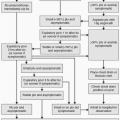Ovarian and Pelvic Vein Embolization
Lindsay Machan
Indications
1. Unexplained chronic pelvic pain
2. Pelvic varicosities seen at laparoscopy, ultrasound, or open operation in a patient with appropriate symptoms
3. Lower extremity varicose veins recurrent immediately after adequate surgical treatment or of an atypical distribution
4. Symptomatic labial/perineal varicosities
Contraindications
1. Contraindications to angiography
a. Severe anaphylactoid reactions to radiographic contrast media
b. Uncorrectable coagulopathy
c. Severe renal insufficiency
2. Phobia to medical implants
3. Another cause of pelvic pain not adequately treated coexists (relative).
Preprocedure Preparation
Pretreatment Assessment
1. If the patient suffers from pelvic pain
a. Detailed clinical assessment by gynecologist or pelvic pain specialist
b. Diagnostic laparoscopy
d. Patient education: Even before diagnostic venography, the patient should be informed that pelvic congestion syndrome is controversial and is not accepted as a cause of pelvic pain by many physicians (2,3). Gynecologists will frequently see dilated pelvic veins in parous women who don’t have symptoms and may not see dilated veins in patients who do. Pelvic venous ectasia can be a normal consequence of pregnancy but flow is antegrade, whereas in pelvic congestion syndrome, the patients have retrograde flow in the ovarian vein. Chronic pelvic pain does not respond to embolization in all patients and as with other chronic pain syndromes may take up to 6 months to respond.
2. If the patient suffers from lower extremity varicosities
a. Detailed clinical assessment by physician expert in venous disease
b. Lower extremity duplex ultrasound assessment of venous reflux
Patient Preparation
1. Timing of the procedure in relation to menstrual or pain cycle is unimportant.
2. Clear fluids after midnight for morning appointment, clear fluids after breakfast for afternoon appointment
3. Admit the patient to a day care bed. Obtain informed consent. Make sure someone can drive the patient home.
4. Establish a peripheral intravenous (IV) line.







